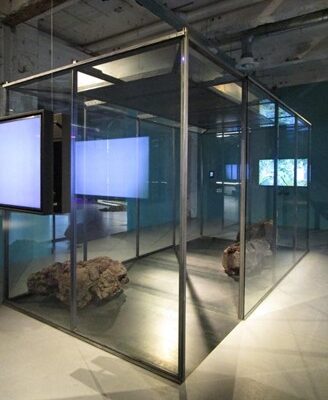設計師Jonathan Ho和生態科學家喬里斯.科恩(Joris Koene)合作的生物藝術計畫《性殼:現代性別流動》(Sex Shells: Gender fluidity in the modern age, 2019,簡稱《性殼》),是荷蘭2019年生物藝術與設計大獎(Bio Art & Design Award, BAD award)的得獎作品之一。展場中央的水族箱,散布著數隻鑲嵌水鑽及彩繪的活蝸牛,水族箱底下鋪著蝸牛造型圖案的居家地毯。三面環牆的黑白灰階投影,慢動作播放蝸牛交媾時的感性扭動,接續蝸牛造型的皮革愛好者彼此撫摸。Ho的設計長期聚焦在戀物美學和性產業,此作品結合蝸牛的跨性交配和戀物社群的親密實踐,或許也交織了人與蝸牛的情慾邊界。得獎介紹寫到,這件作品將雌雄同體的淡水蝸牛作為性別流動的「隱喻」(metaphor),以探索當代人類性別的多元可能。
隱喻嗎?生物藝術是21世紀新興的跨領域藝術創作,然而把生物作為人類社會的隱喻,其實是非常古老的做法,可以溯及遠古石窟的動物壁畫。讓我不安的不是做法有多古老,而是人與生物之間的互動關係沒有在作品中進一步展開。確實,雌雄同體的蝸牛可以比擬現代人類社會中的性別框架,但是,《性殼》的佈展裝置似乎隱含了另一種不對等的關係:人與動物。哲學家約翰.伯格(John Berger)在〈為何凝視動物?〉(Why Look at Animals?)一文中寫到,自遠古時期,動物就不僅是人類語言中的隱喻,而是相互影響的行動者。人看著動物,動物也回望著人。動物被食用也被崇拜,彼此形成微妙的互生關係。伴隨資本工業的發展,動物的凝視逐漸消散,取而代之的是動物的圖像、玩偶、迪士尼卡通、寵物、和動物園。尤其是動物園,讓人可以看見自然,卻反而證明了動物在人類社會中的缺席。柵欄中的動物失去在自然中的求生行為,覓食、求偶都被養殖員控制,卻被當作是自然的珍奇象徵。動物不再有能動性,僅供人觀賞。1
《性殼》在水族箱中花枝招展的扮裝蝸牛,不幸地,令人聯想到伯格為動物所寫下的這篇訃聞。水族箱內的蝸牛是被看的對象,水族箱的設計已經預設了人類作為唯一主體的觀看方式。不論是成為地毯造型,活著的蝸牛被加上創作者的水鑽變裝,以及科學家透過神經手術限定蝸牛的性別,蝸牛在展間裝置中的角色,其實更接近動物園裡的珍奇異獸,是一種馴化的自然。雖然《性殼》的目的是在反諷男女二元的性別文化框架,但是,假如生物藝術旨在透過生物來反思以人類為中心的思考模式,蝸牛是怎麼想的?蝸牛可以發聲嗎?如果蝸牛會說人話,牠們會如何評論《性殼》的展場裝置?
 Jonathan Ho和喬里斯.科恩(Joris Koene)合作的《性殼:現代性別流動》(Sex Shells: Gender fluidity in the modern age, 2019)展出現場。圖/游量凱攝影
Jonathan Ho和喬里斯.科恩(Joris Koene)合作的《性殼:現代性別流動》(Sex Shells: Gender fluidity in the modern age, 2019)展出現場。圖/游量凱攝影
假使活著的蝸牛無法發聲,滅絕的物種又能說什麼?從Youtube上流傳的絕種奧亞吸蜜鳥(Moho braccatus)的求偶叫聲出發,科技媒體藝術家雅各布.庫茲克.斯滕森(Jakob Kudsk Steensen)的作品《再生》(Re-Animated, 2018-2019)運用電玩影像工程來建構絕種鳥類轉生的科幻烏托邦。看似是一則典型生態浩劫的道德故事,用滅絕物種來批判現代社會的發展,其實,沉浸在其中才能體會《再生》的複雜敘事。環繞在VR裝置的三面牆上的影音,分別講述了生物學家對於吸蜜鳥的個人記憶,棲地夏威夷島嶼的生態史,以及最後一面沒有人聲的影音,只有循環播放吸蜜鳥求偶叫聲、視覺動畫,和掛在如博物館白牆上的吸蜜鳥標本。從夏威夷島嶼的生態史旁白開始,斯滕森便企圖在吸蜜鳥的物種生命歷程中,囊括不同的行動者:鳥類、傳教士、生物學家、蚊蟲、疾病、標本展示等,人與動物交互作用在殖民和生態網絡之中,人既不是置身於自然之外,也不是全能的自然主宰。而到展場中心的VR裝置,觀眾進入一處藝術家調查實景後重新擬造的自然世界,在偌大的叢林河流之間穿梭,視角從地面、水中到高空之間緩慢轉動。觀眾仍只能偶爾聽見吸蜜鳥的求偶叫聲,沒有吸蜜鳥再生的蹤影,只有如墓碑一般矗立的吸蜜鳥標本畫像。事後看藝術家接受訪談才知道,VR頭罩上的收音裝置會感應觀眾的呼吸,所以每個人所沉浸的《再生》版本都有著不同的節奏。2相同或許是,吸蜜鳥的「再生」是不可能的,藝術家並沒有用影像技術來許諾虛假的未來圖景,需要「再生」的是人感知自然的方式。
 雅各布.庫茲克.斯滕森(Jakob Kudsk Steensen)的作品《再生》(Re-Animated, 2018-2019)運用電玩影像工程來建構絕種鳥類轉生的科幻烏托邦,作品局部。圖/游量凱攝影
雅各布.庫茲克.斯滕森(Jakob Kudsk Steensen)的作品《再生》(Re-Animated, 2018-2019)運用電玩影像工程來建構絕種鳥類轉生的科幻烏托邦,作品局部。圖/游量凱攝影
 亞歷山德拉.黛西.金斯伯格(Alexandra Daisy Ginsberg)和西塞爾.托拉斯(Sissel Tolaas)合作的作品《崇高復生》(Resurrecting the Sublime, 2019)展出現場。圖/游量凱攝影
亞歷山德拉.黛西.金斯伯格(Alexandra Daisy Ginsberg)和西塞爾.托拉斯(Sissel Tolaas)合作的作品《崇高復生》(Resurrecting the Sublime, 2019)展出現場。圖/游量凱攝影
展場中對應《再生》的作品,是同樣轉化滅絕物種的《崇高復生》(Resurrecting the Sublime, 2019)。藝術家亞歷山德拉.黛西.金斯伯格(Alexandra Daisy Ginsberg)、西塞爾.托拉斯(Sissel Tolaas)和生物科技實驗室合作,由生物學家從20世紀初因為殖民畜牧而絕種的錦葵植物DNA,嘗試模擬該植株的香氣。藝術家在展場打造了玻璃櫃裝置,玻璃櫃中只有三塊火山岩石,是科學家得以找到植物DNA的關鍵。忽然間,植物的香氣在櫃中釋放,我們如何能夠得知這就是滅絕植物的氣味?其實《崇高復生》沒有提供答案,在介紹的影音中藝術家也承認重現氣味是不可能的,科學技術僅能模擬近似的氣味分子。生態文學學者厄休拉.K.海瑟(Ursula K. Heise)在《想像中的滅絕:瀕危動物的文化意義》一書中指出,19世紀達爾文演化論以來,歐美社會對於生態滅絕的焦慮心態,很多時候反映的不全是生態危機,而是社會的自我認知和價值判斷。3相較於《再生》,《崇高復生》沒有提供「崇高」的視覺奇觀,而是透過嗅覺的稍縱即逝,指向不再復返的滅絕。如同《再生》的VR裝置,《崇高復生》也沒有讓人置身於自然之外,讓觀眾走入的玻璃櫃設計,使觀眾的身體也成為展品之一,巧妙折射出框架自然標本的展示文化。《崇高復生》透過氣味的體驗來走出視覺中心的主宰,比起直接使用或展示生物的身體,或許更能夠讓觀眾親身摸索另一種人與自然的互動關係。
在諸多運用動植物的生物藝術計畫之中,夏洛特.賈薇斯(Charlotte Jarvis)的作品《In Posse》(拉丁文有「出生之前」的意思)回到人的身體邊界。與荷蘭萊頓大學醫學院的胚胎學家Susana Chuva de Sousa Lopes合作,賈薇斯用女性的血清來製作人工精液,藉此挑戰精液在性別文化中的陽剛形象。精液在父權文化的想像中,有時被當作生殖力、腦力或血液,在色情片的視覺文化中,也經常是代表高潮的視覺奇觀。藝術家提問,若女性也擁有如此神奇的精液,會如何擾動既有的性別秩序?《In Posse》企圖同時挑戰藝術、科學和文化想像,交錯體現在展場裝置的三角餐桌上。桌上混雜了大量的泥土、餐盤、蠟燭、實驗設計筆記,模糊了科學與儀式的區隔。桌上三邊各有一個影音屏幕,第一個螢幕有個小標「像天才一樣作畫」(Paint Like a Genius),賈薇斯穿上假陽具以粉紅顏料塗抹作畫,不時狂野躁動地把玩陽剛象徵,生猛戲謔了戰後歐美藝術史正典中充滿陽剛氣質的行動畫派。第二個螢幕總結《In Posse》的創作過程,藝術家和志願參與的女性共同創作,想像古希臘的「Thesmophoria」(暫譯為「地母節」)慶典。「地母節」是僅限女性參與的神秘儀式,卻也因此在父權文化主導的歷史記憶中少有文獻紀錄。《In Posse》透過陰性精液來想像這個佚失的節慶,也透過儀式來反詰科學的理性思維。第三個螢幕記錄了實驗的過程,藝術家徵集了13位女性參與捐血,以製作人工精液的血清蛋白,也共同討論實驗程序和展場布置,她們都是藝術家共同創作的夥伴,而不只是被動的捐贈者。在一場演說中,賈薇斯特別強調她不使用科學界常用的牛血清蛋白,以抗拒人與自然之間的不對等關係。藉此,藝術家不僅只是借用科學技術來進行藝術創作,也回過頭來省思科學實驗體制中的父權階層運作(諸如兩性、科學家與捐贈者、人與動物),試圖創造新的實驗生產模式。4
 夏洛特.賈薇斯(Charlotte Jarvis)的作品《In Posse》。圖/游量凱攝影
夏洛特.賈薇斯(Charlotte Jarvis)的作品《In Posse》。圖/游量凱攝影
 夏洛特.賈薇斯(Charlotte Jarvis)的作品《In Posse》局部。圖/游量凱攝影
夏洛特.賈薇斯(Charlotte Jarvis)的作品《In Posse》局部。圖/游量凱攝影
《In Posse》餐桌對面還有一面巨大投影,對稱的黏液有機體緩慢進行拋物線的運動,使我又回想到《性殼》中的蝸牛蠕動。不過就視覺呈現、裝置設計和參與方式來說,《In Posse》對於跨科學和藝術領域中各種人與生物、觀看、性別等權力關係更加敏銳。賈薇斯更早的計畫包括《新勞動》(New Labour),則是想像女性在世界中絕跡,不需要在父權社會中承擔繁衍後代的工作,而由男性來承擔,顛覆性別分工並開拓多元成家的想像。這也令我想起酷兒理論學者李.艾德曼(Lee Edelman)所批判的「生殖未來主義」(reproductive futurism),資本主義社會的拓展,總是構築在子孫會獲得更好未來的想像之上。或許生物藝術的激進實踐,不論從物種滅亡或生殖技術的角度,來拓展肉身的邊界、感官經驗和時空交錯的相遇,都試圖對這種未來主義保持距離。